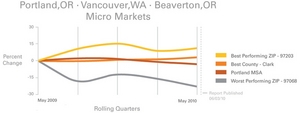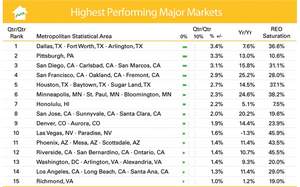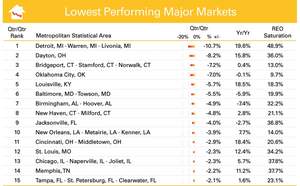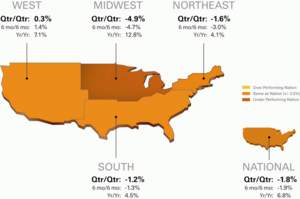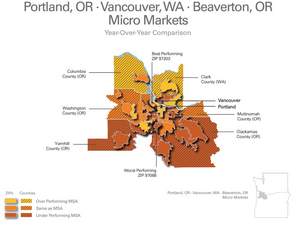TRUCKEE, CA--(Marketwire - June 3, 2010) - Clear Capital (www.clearcapital.com), a premium provider of data and solutions for real estate asset valuation, investment and risk assessment, today released its Home Data Index™ (HDI) Market Report. Patent pending rolling quarter technology significantly reduces the multi-month lag time associated with other indices to help investors, loan servicers and individual buyers and sellers make more informed, timely and profitable decisions.
Report highlights include:
-
National / Four Region Overview: After a winter of slowed housing gains, national year-over-year prices edged upward to 6.8% -- its highest mark since July 2006. Similarly, the national quarter-over-quarter home price change of -1.8% is a substantial improvement over last month's reported -5.0% quarterly change. While quarterly prices for three of four regions remain negative, the national REO saturation rate dropped to 27.8%, an improvement from the 41.7% rate this time last year.
-
Metropolitan Statistical Area (MSA) drilldown: All the highest performing major markets experienced quarterly price gains. Dallas, Texas was this month's highest performing MSA with a quarterly price increase of 3.4 percent. Even the lowest performing major markets saw significant overall improvement over last month's report, cutting their quarterly losses in half.
-
Micro Market Analysis: Home price declines for the micro markets in the Portland, Ore. area have slowed considerably with current prices just 1.5 percent below their levels a year ago. The area's reputation for having a high quality of life, advanced urban planning and industrial diversity has helped mute the effects of the housing downturn.
The Clear Capital HDI Market Report offers the industry, investors and lenders a timely look at pricing conditions, not only at the national and metropolitan level, but within local markets as well. Clear Capital data is built on the most recent data available from recorder/assessor offices, and then further enhanced by adding the Company's proprietary market data for the most comprehensive geographic coverage available.
"We continue to see sustained price growth throughout much of the country with yearly price gains reflecting the housing recovery off of last year's lows," said Dr. Alex Villacorta, Senior Statistician, Clear Capital. "The expiration of the tax credit at the end of April has certainly contributed to the growth of prices we are observing, and as more sales close before the June 30 deadline, we expect that markets across the country will continue to see strengthening of prices."
"It is interesting to note, however, that this current momentum is a far cry from where we were a year ago," added Villacorta. "In June of last year, we reported a national yearly decline of 19.3 percent, whereas the present report shows a 6.8 percent gain. Similarly, the present REO saturation rate of 27.8 percent is a significant improvement from last year's 41.7 percent. This dramatic shift in price trends reflects the unprecedented volatility over the last couple of years and the delicate state of local real estate markets around the country."
National/Four Region Market Overview (May 2009 - May 2010)
After a winter of slowed housing gains, national yearly prices edged upward to 6.8 percent -- its highest mark since July 2006. This increase was largely aided by the end of the tax credit in April and start of the spring buying season. May's gains followed the back-to-back 5.1 percent yearly gains achieved in March and April. Similarly, the quarterly loss for the Nation (-1.8%) is a substantial improvement over the -5.0 percent price change reported last month and marks the first month-over-month improvement since February's report. In addition, the national REO saturation rate dropped 1.8 percentage points to 27.8 percent, an improvement from the 41.7 percent rate this time last year.
These numbers are a good sign that the market has begun to turn around off last year's lows. When the first Clear Capital HDI Market Report was released one year ago this month, the national year-over-year price change was an eye-opening -19.3 percent.
Additionally, this month's improvement is reflected across all four U.S. regions, with the Midwest experiencing the largest jump (4.5 percentage points) bringing its current quarterly price change to -4.9 percent. While quarterly prices remain negative in three of the four regions, yearly gains remained intact. As tax-credit incentivized sales continue to close through June, it's likely prices will maintain their positive momentum heading into the summer months.
Metro Markets (May 2009 - May 2010)
The regional improvements extended to the highest performing major markets, pushing all quarterly price gains on the list into positive territory. Dallas, Texas, leads this month's list with a price increase of 3.4 percent from late 2009. The REO saturation rate also fell 4.5 percentage points in Dallas, to 36.6 percent.
San Jose, Calif. saw the largest reduction in its quarterly REO saturation, falling 5.5 percentage points from last month's report to 19.6 percent. This reduction in the REO saturation helped propel San Jose's yearly price gain to 20.2 percent. Neighboring San Francisco also fared well, posting the largest year-over-year gain (25.2%).
Only Las Vegas reported a negative yearly price change (-1.3%). The Las Vegas, Nev. Quarterly REO saturation rate remained high (45.9%), despite a slight 1.5 percentage point improvement from last month's report. However, recent improved price movements in Las Vegas have been sufficient enough to improve yearly losses from -7.2 percent in last month's report to its current -1.3 percent mark.
Detroit, Mich. landed the top position among the lowest performing major markets this month. However, Detroit's -10.7 percent quarterly price change is a substantial improvement over last month's -14.4 percent quarterly change. Detroit is indicative of the overall improvement among the entire set.
All of these markets improved their quarterly losses from last month's report, this month averaging a -4.9 percent price change compared to -11.1 percent last month. Additionally, thirteen improved their yearly numbers, and twelve improved their REO saturation rates. And the exceptions were modestly off, with yearly prices falling 2.7 percentage points in Oklahoma City, Okla., and only 0.2 percentage points in Tampa Fla. REO saturation rose only 0.6 percent in both Bridgeport, Conn. and Baltimore, Md.; while New Haven, Conn. held steady.
Memphis, Tenn. -- last month's lowest performing major market -- moved down to fourteenth position, helped by a 5.7 percentage point reduction in REO saturation, and largest quarterly price improvement among this group.
Micro Markets (May 2009 - May 2010)
This section highlights a single market every month with a deeper dive into how the micro- and macro-markets relate to each other.
While prices as a whole for the Portland/Vancouver/Beaverton MSA have slid 22.5 percent since this market peaked in mid-2007, the area has been spared some of the larger price declines and higher REO saturation rates (Portland's rate is currently 17.6%) frequently found elsewhere on the west coast. Home price declines in the Portland area have slowed considerably with current prices just 1.5 percent below their levels a year ago. The area's reputation for having a high quality of life, advanced urban planning and industrial diversity has helped mute the effects of the housing downturn.
At the most northwestern end of North Portland is ZIP code 97203 -- the best performing micro market in this MSA. This market area is a convenient and diverse location that embodies mostly older, well-kept homes at reasonable prices. Close to downtown, with easy access to the University of Portland, and in-between the industrial rail and shipping hubs, this area has attracted new home buyers and investors -- the prevalent types of homebuyers in recent months. Prices have risen 8.5 percent for the year and, while home buying is still soft by pre-peak standards, it has managed to turn in a 0.3 percent price gain in the recent quarter.
West Linn, Ore. (ZIP 97068), the worst performing ZIP code in this MSA, is also conveniently located in a community south of downtown Portland and north of Salem, Ore. However, West Linn includes a mix of mostly single family residence that average double the size and price of the North Portland homes. With purchase prices ranging into the millions and a small renter base, this more suburban area on the outskirts of Portland's urban growth boundary is less appealing to the recent buyer pool that's looking for affordable first time purchases or rental property. Subsequently, prices haven't found a bottom in this market, and have dropped 21.7 percent over the last year.
Clear Capital Home Data Index™ Methodology
The Clear Capital Home Data Index (HDI) provides weighted repeat sales, and price-per-square-foot index models that use multiple sale types, including single-family homes, multi-family homes and condominiums. These models are combined with an address-level cascade to provide sale-type-specific analysis for thousands of geographic areas across the country. The indices include both fair market and institutional (real estate owned) transactions. They also provide indicators of REO activity such as REO discount rates, REO days on market and REO saturation. The Clear Capital HDI generates indices in patent pending rolling quarter intervals that compare the most recent four months to the previous three months. The rolling quarters have no fixed start date and can be used to generate indices as data flows in, or at any arbitrary time period.
About Clear Capital
Clear Capital (www.clearcapital.com) is a premium provider of data and solutions for real estate asset valuation and risk assessment for large financial services companies. Our products include appraisals, broker-price opinions, property condition inspections, value reconciliations, and home data indices. Clear Capital's combination of progressive technology, high caliber in-house staff and a well-trained network of more than 40,000 field experts sets a new standard for accurate, up-to-date and well documented valuation data and assessments. The Company's customers include 75 percent of the largest U.S. banks, investment firms and other financial organizations.
Legend
Address Level Cascade - Provides the most granular market data available. From the subject property, progressively steps out from the smallest market to larger markets until data density and statistical confidence are sufficient to return a market trend.
Home Data Index (HDI) - Major intelligence offering that provides contextual data augmenting other, human-based valuation tools. Clear Capital's multi-model approach combines address-level accuracy with the most current proprietary home pricing data available.
Metropolitan Statistical Area (MSA) - Geographic entities defined by the U.S. Office of Management and Budget (OMB) for use by Federal statistical agencies in collecting, tabulating, and publishing Federal statistics.
Repeat Sales Model - Weighted linear model based on repeat sales of same property over time.
Price Per Square Foot (PPSF) Model - Median price movement of sale prices divided by square footage over a period of time -- most commonly a quarter.
Real Estate Owned (REO) Saturation - Calculates the percentage of REOs sold as compared to all properties sold in the last rolling quarter.
Rolling Quarters - Patent pending rolling quarters compare the most recent four months to the previous three months.
The information contained in this report is based on sources that are deemed to be reliable; however no representation or warranty is made as to the accuracy, completeness, or fitness for any particular purpose of any information contained herein. This report is not intended as investment advice, and should not be viewed as any guarantee of value, condition, or other attribute.
Contact Information:
Media Contact:
Michelle Sabolich
Atomic PR for Clear Capital
415.593.1400
